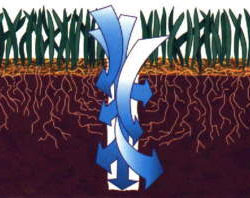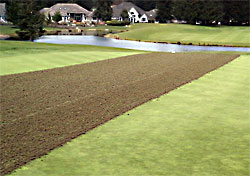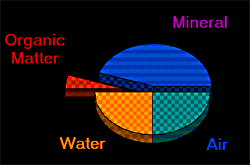|
The Root of Greed...
Dustin Riley, Oconomowoc Country Club, Oconomowoc, WI:
 "Call me greedy, but I like deep, healthy roots on turf, especially on our greens. Deep and healthy roots provide the plants with the ability to mine nutrients and water from the soil and convert those materials into food through the process of photosynthesis. Deep and healthy roots are the storage areas for extra food. Deep and healthy roots help the turf withstand heat, drought, cart traffic, etc.
A deep and healthy root system isn't an accident. Many management practices are implemented to maximize root growth. One of the most important of these practices is occurring this week... the practice of Deep-tine Aeration."
 Deep-tine aeration pokes a long, solid spike into the putting surface. Although millions of holes are being punched, we are only affecting 3.5% of the putting surface. Each 9" deep x ¾" hole relieves compaction and creates a channel for fresh air and water to enter. A layer of sand on the putting surface is brushed until each channel is filled. Sometimes the sand bridges within the hole and doesn't allow for a complete filling of sand. This can be very beneficial. The pocket of air remaining in the bottom portion of the channel becomes a perfect environment for new root development. When new root growth reaches these open channels, the roots fill the voids and can extend down 10+ inches. We witness this benefit during our normal cup changing practices. Upon removing the 6" deep plug from the new pin location, roots will be hanging out several inches of a deep-tine channel.
Some other factors that promote a deep, expansive root system include:
- Proper water management. Over watering encourages short, lazy roots. Allowing the soil profile to remain on the drier side, encourages deep, aggressive roots.
"Think of the grass blades as little solar panels. The larger the panel, the more energy (food) can be created and stored..." |
- Maximizing photosynthetic capabilities by not mowing the turf too short, too soon. Think of the grass blades as little solar panels. The larger the panel, the more energy (food) can be created and stored.
- Proper fertilization will promote root growth during ideal temperatures. Improper fertilization causes the turf leaves to grow at an accelerated rate at the expense of the root system. So, 'just fertilizing' isn't always the best thing.
- Continued soil aeration by venting the putting surfaces with needle tines.
The speed of recovery from deep-tine aeration will be directly influenced by the weather. In a normal year, the putting surfaces will be 95% healed in 7-10 days. If night time temperatures continue to remain cold, the frosty mornings could slow the growth rate of the grass. Besides growing over the deep-tine hole, the turf must also grow through the 50 tons of sand that has been applied to the surfaces. The greens maintenance will be alternated with rolling and mowing to reduce the mechanical damage from the mowers. Once healed, we'll begin slowly reducing mowing heights and preparing for summer playing conditions, set to develop a deep and healthy root system.
Let the greediness begin."
Visit Dustin's blog at ocongolfclubgrounds.blogspot.com.
|
 |
|
Range Use Tutorial...
Michael Stachowicz, Dedham Country and Polo Club, Dedham, MA:
  "This video from the Philadelphia Cricket Club is a great tutorial on how to use our range tee to its greatest potential. This is very well done.
Golf has changed in the past few years and we have seen this industry wide... golfers are spending more time on the practice tee and less time on the golf course. This makes sense as people's time is more precious and spending an hour on the range is a reasonable alternative to spending four or five hours on the golf course.
DCPC has seen this change as well. This factor combined with the elimination of range fees has led to more use on our range than it can really comfortably handle. For good turf conditions, for everyone all season long it will take a partnership between the golfers, the pro shop staff, and the grounds staff."
Visit Michael's blog at mstachowicz.wordpress.com
|
 |
|
Arid April...
David Smith, Fawn Lake Country Club, Spotsylvania, VA:
  "Just a couple of weeks ago we were under heavy fog advisories for an entire week. There was plenty of moisture in the air and almost no breeze. Today we are into our second week of 10-20% humidity, 15-25mph winds, and higher than normal temperatures. Instead of fog advisories there is a fire threat.
In the picture you can see what happens to the water we try and apply to dry areas on greens. Instead of soaking into the soil it runs across the surface. We spiked greens last Monday with solid tines to help give them some relief. It helped, but a little rain would still be nice."
Visit David's blog at flccturfcare.blogspot.com.
|
 |
|
Beginning a New Chapter in My Career...
David Phipps, Stone Creek Golf Club, Oregon City, OR:
 "I have developed a passion for this industry and the environment in which the game is played, and have had opportunities to serve in many capacities, both locally and nationally. I have decided to pursue this passion and have accepted the NW Region Field Staff position with the GCSAA. I have been to the GCSAA headquarters in Lawrence Kansas many times and had never imagined that I would actually be working for such an outstanding organization. I am thrilled to be offered the opportunity to work with them and to also be connecting with so many wonderful superintendents and their chapters in my eight state region. I will be serving Alaska, Washington, Oregon, Utah, Colorado, Wyoming, Montana, and Idaho.
"...the opportunity to build a golf course and manage it for years down the road, know what I'm talking about when I say it becomes part of your soul." |
Those superintendents that have had the opportunity to build a golf course and manage it for years down the road, know what I'm talking about when I say it becomes part of your soul. Stone Creek has become such a part of me and my family. The day has finally arrived now that I feel I have served the course to my fullest, so I have decide to move on to a new venture. Stone Creek has been been a ride of a life time. Since I started this blog in 2009, I never had a chance to talk about the construction of Stone Creek. In this, my final post, I would like to give a brief history of the construction and recognize some of the key individuals that have contributed to its success. [read MUCH MORE here...]
Visit David's blog at stonecreeksuper.blogspot.com.
|
 |
|
Spring Aerification...
Justin Ruiz, CGCS MG, Indian Summer Golf and Country Club, Olympia, WA :
  "Spring is the time for us as Turfgrass Managers, to start thinking of the new season that will be upon us in just a few short months. It is an important time to prepare the turf for the stresses of the summer heat, and relentless pest pressure. To prepare the turf, we use a combination of cultural practices including the most important one, core aerification.
The turf grows in a unique environment, getting nutrients and life support from the soil. An ideal soil system is 50% insoluble material, while the other 50% is made up of 25% water, and 25% oxygen. If you noticed, I mentioned 'ideal'. Over the winter months the soil has become saturated with water, and since the insoluble material cannot be displaced, oxygen is pushed from the soil system, leaving the turf in a less than desirable situation.
 With that being said, as turf managers, we make the decision to core aerify the turf. The goal is to balance the soil's three part system, while also removing unwanted thatch created by the natural attrition of the shoots, roots, and stems. The process also enhances nutrient uptake while the plant begins the root driving process. We remove about 10% of the turf's surface. To offset thatch buildup, removal of 20% of the surface per year is recommended by the USGA. That gives us the reasoning behind the need of twice per year. Click here for the recommendations of the USGA.
Core aerification is a disruptive process. Playing conditions will be affected for up to four weeks, depending upon weather. An application of fertilizer, one week before aerification day, will get the plant growing rapidly. Expect reduced green speeds coming into aerification. The day of aerification, after we have filled the holes completely with sand, we will apply another application of fertilizer. The purpose of increased fertility during this process is to speed up the healing process and give the plant the nutrition it needs to grow roots."
Visit Justin's blog at indiansummergolf.blogspot.com
|
 |
|
Another One in the Books...
Sean McCue, The Country Club at Castle Pines, CO:
 "The last three days were spent aerifing the course to prepare it form the upcoming season. We completed aerification of greens, tees and fairways. In addition to that we handled more than 700 tons of sand that was applied to the freshly punched turf. Needless to say it is a monumental task moving that much material around the golf course.
This year we used a Verti-Drain deep tine aerifer on greens that was set at a depth of 9" with 1/4" solid times. At first glance the greens appear as if they were not aerified but that is not the case. The surface impact appears minimal but a deep fracturing of the soil has taken place now allowing free movement of oxygen and water into the rootzone. The end result will be a deeper healthier root system of the plant.
"We took the liberty of 'sneaking in' a couple of punches on the fairways back in March with the weather cooperating with us. These multiple aerifications will greatly help us control..." |
The fairways have been aerified a total of three times in the last four weeks. We took the liberty of 'sneaking in' a couple of punches on the fairways back in March with the weather cooperating with us. These multiple aerifications will greatly help us control our surface firmness and allow numerous channels to be filled with sand. Over the course of the three fairway aerifications 4.5 million holes per acre were punched and 600 tons of sand was applied to the fairways alone.
Right now the fairways more closely resemble bunkers than anything else, but over the next week the grass will once again push through and start help the sand to work it's way down. The next several mowings will be extremely rough on the equipment but the end result is all that matters."
Visit Sean's blog at cccpgcm.blogspot.com.
|
 |
Look who's stylin' now! John Slade, of Laurel Creek Country Club in Mount Laurel, NJ, has a new blog theme with custom header courtesy of TurfNet. We would be happy to do that for other TurfNet member/bloggers as well. All we need are a few good course photos (at least 1000px wide), a club logo and a few head shots to work with.

|
 |
|
About our Blog Aggregator: Many superintendents are now hosting private blogs to better communicate with their golfers and/or members. Beyond local weather and course conditions, there is a great deal of information about projects, methodologies and techniques that would be of value to other superintendents — hence our Turf Blog Aggregator. As every blogger struggles occasionally with content, we also include posts intended to educate golfers about turf maintenance for others to use as a template for their own blogs.
Miss any previous issues of TBA? You can find them all here.
Turf Blog Aggregator(TM) is a trademark of Turnstile Media Group.
|
|